Last Updated on November 28, 2025
Introduction to banking software
Banking software oversees a plethora of transactions, from the mundane to the complex, and the seamless execution of operations that keep the economic world spinning.
In 2023, the core banking software market stood at USD 14.54 billion, with forecasts suggesting a surge to USD 62.75 billion by 2032, propelled by a CAGR of 17.7%. This growth trajectory underscores the pivotal role of banking software in enhancing operational efficiencies, facilitating seamless transactions, and steering the digital shift within the banking sector
From the simplicity of checking balances on your smartphone to the complex inner workings of global fund transfers, banking software is the silent, steadfast sentinel safeguarding billions of daily transactions.
Whether you’re a finance professional, a tech enthusiast, or someone fascinated by the transformational power of technology, there’s something in this article for you. Read on as we put together the list of the best banking software available in the market today.
Quick Read: Banking as a Service (Baas): What It Is and Why It Is Important?
A comparison table of banking software
Software |
Market segment |
Ratings out of 5 |
Top Features |
Alkami Platform |
Mid-market |
4.4 |
Self-service banking and mobility |
Mercury |
Small businesses and startups |
4.5 |
Quality of support and ease of use |
Temenos Transact |
Mid-market and enterprise |
4.5 |
Customization and scalability |
Finacle |
Enterprise |
4.1 |
Ease of use and quality of support |
Flinks |
Small business |
4.4 |
Reporting and financial insights |
Turnkey Lender |
Small business |
4.7 |
Ease of use and robust loan management system |
Appway Digital Banking |
Small business |
4.3 |
Quality of support and ease of use |
iCBS |
Mid-market and enterprise |
4.2 |
User-friendliness and customization |
Finflux |
Enterprise |
4.7 |
Loan origination and customization |
MX |
Small business and mid-market |
4.7 |
Ease of use and APIs |
*These ratings and top features are taken from review platforms like G2, Capterra, TrustRadius, and others. Links to the respective platform are in the subsequent software sections.
List of TOP 10 banking software
- Alkami Platform
- Mercury
- Temenos Transact
- Finacle
- Flinks
- Trunkey Lender
- Appway Digital Banking
- iCBS
- Finflux
- MX
Banking Software – Explained in detail
Let’s dive into the details of the top ten banking software on the market.
1. Alkami Platform
Alkami allows your customer to experience a seamless banking experience. It offers customization capabilities, helping you stand out among the competition on the market.
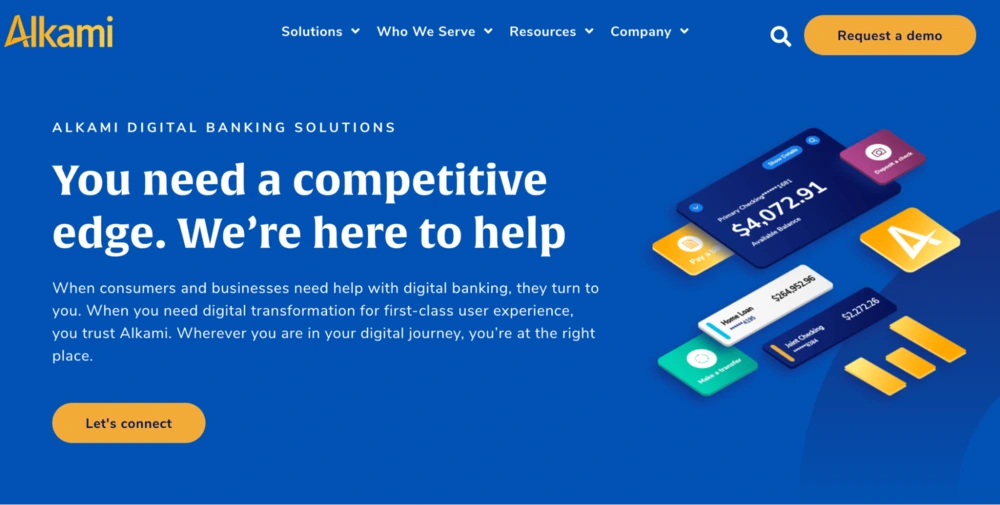
Features of Alkami Platform
Below are some notable features of the Alkami Platform.
- Digital account opening simplifies the process of opening an account, delivering a seamless, fully digital user experience.
- Card experience to manage cards with a user-friendly interface, promoting better control and greater convenience.
- Remarkable customer service to provide an accessible and responsive support system.
- Financial wellness to manage financial health, fostering a robust understanding of personal finance.
- Money movement to manage funds, ensuring easy and secure transactions.
- Extensibility to be adaptable and upgradeable, anticipating future market needs and demands.
- Security and fraud protection prevent threats and allow users to focus on crucial banking tasks.
Benefits of using Alkami Platform
Alkami platform offers several benefits to its users, including:
- Efficient insights to put their knowledge to work.
- Future-proof solution ensures that the platform can meet future market demands.
- A single code base and a multi-tenant system architecture ensure you can quickly meet changing market demands and keep users engaged.
- Cloud-based system to offer maximum availability, resiliency, and industry-leading security.
- Integrations on a secure and scalable platform enable connections to a vast solution ecosystem.
Pros and cons
Pros |
Cons |
|
Ease of integration with partners |
Complicated admin settings (G2) |
|
Simple and easy to follow |
Lead time for custom improvements is lengthy (G2) |
|
Easy to navigate the portal |
Bit slow to build on the foundational features like reports (G2) |
Pricing
Alkami platform provides custom pricing based on an organization’s requirements from the banking solution. Contact the team to get a quote.
Rating
Users give the Alkami platform 4.4 out of 5 stars on popular reviews platforms.
2. Mercury
Mercury offers a streamlined application process, enabling users to get started with corporate and retail banking in a few minutes. With its advanced tools and services, Mercury is not just a financial platform; it’s a partner helping businesses grow and scale.

Features of Mercury
Below are some notable features of Mercury.
- Banking basics: Store, manage, and move funds efficiently with FDIC-insured checking and savings accounts.
- Employee debit cards: Easily issue employee debit cards, facilitating seamless financial management.
- Payment options. Pay vendors and employees through various channels, including automated clearing house (ACH), wires, checks, and foreign exchange.
- Credit cards: Scale your team confidently with credit cards and earn 1.5% cashback.
- High yield on idle cash:Earn up to 5.04% yield on your idle cash with access to mutual funds through Mercury Treasury.
Benefits of using Mercury
Mercury offers several benefits, including:
- Efficient banking: With Mercury, startups get a banking system built to support their fast-paced growth and innovation.
- Customizable tools: From issuing cards with custom limits to naming accounts for any purpose, Mercury provides the flexibility startups need.
- Growth support: With features like venture debt and high-yield savings, Mercury offers resources to help businesses grow and scale.
- Automated operations: Automating recurring payments and accounts payable reduces the time spent on administrative tasks, allowing businesses to focus more on growth and less on banking busywork.
Pros and cons
Pros |
Cons |
|
Ability to easily create, delete, and manage virtual cards |
The request payment feature is restricted to an email contact (G2) |
|
Easy to use |
Lack of integrations (G2) |
|
Outstanding customer experience |
Hard to track and view incoming transfers (G2) |
Pricing
Mercury platform provides custom pricing based on an organization’s requirements from the banking solution. Contact the team to get a quote.
Rating
Users give Mercury 4.5 out of 5 stars on popular reviews platforms.
Quick Read: 5 Best Corporate Credit Cards
3. Temenos Transact
Temenos Transact uses cloud-native and agnostic technology to provide rich banking functionality across retail, corporate, treasury, wealth, and payments. The cutting-edge banking technology and flexible and extensive business support allow banks to introduce innovative products and services to their customers.
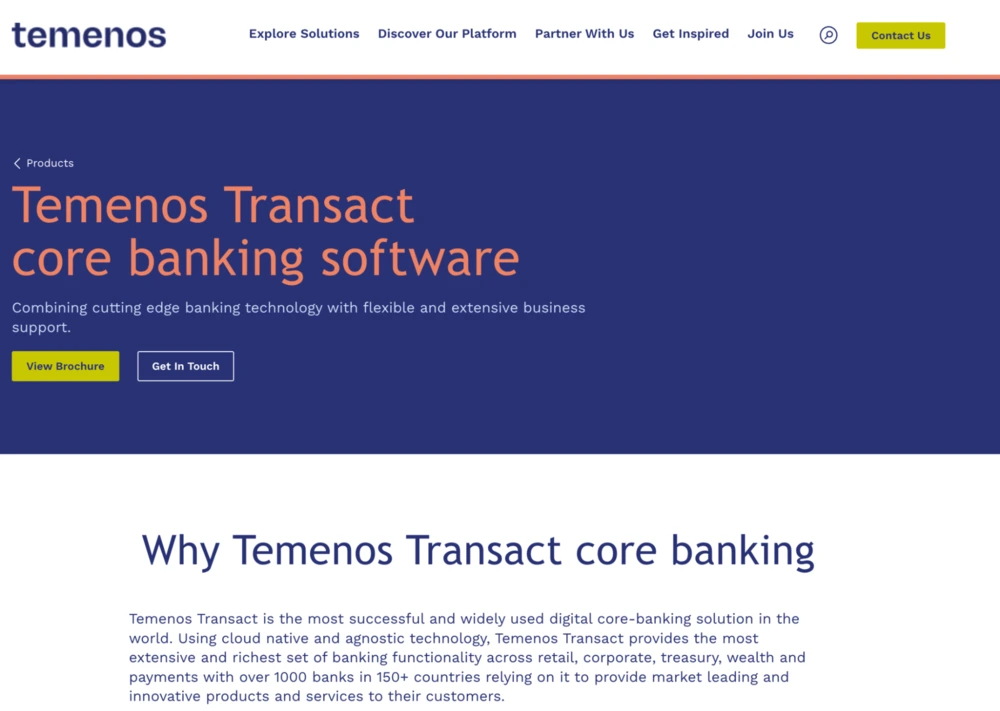
Features of Temenos Transact
Below are some notable features of Temenos Transact.
- Innovation sandbox enables you to utilize the Temenos Banking Cloud for swift innovation and rapid product launches.
- Product diversity allows the introduction of new, relevant, attractive, and innovative products drawn from all sectors.
- Regulation and market practice compliance assure regulatory compliance and timely updates to market standard changes.
- Continual release deployment adds new functionalities with no system downtime ensuring uninterrupted customer services and operations.
Benefits of using Temenos Transact
Temenos Transact offers several benefits, including:
- Continual improvement. Regular monthly releases of new functionality provide banks with new capabilities when available.
- Cost efficiency. The modern digital banking architecture of Temenos Transact enables end-to-end automation and offers services at a more efficient cost point.
- Increased return on equity (ROE). Offering personalized and customer-relevant products lowers operational costs and increases ROE.
- Risk management. Comprehensive risk analytics ensure greater efficiency and better risk-informed decisions.
Pros and cons
Pros |
Cons |
|
Easy to manage all the customers by using customer modules |
Knowledge sharing is minimal with partners or freelancers (G2) |
|
Very fast and reliable |
Modules like securities and wealth management are complex to understand (G2) |
|
Low cost of maintenance |
The application can be unstable and slow, especially when multiple users are logged in (G2) |
Pricing
Temenos Transact provides custom pricing based on an organization’s requirements from the banking solution. Contact the team to get a quote.
Rating
Users give Temenos Transact 4.5 out of 5 stars on popular reviews platforms.
Quick Read: 10 Best Treasury Management Systems
4. Finacle
Finacle offers a functionally-rich suite of solutions that enable banks to engage, innovate, operate, and transform better. It supports core banking, lending, digital engagement, payments, cash management, wealth management, and treasury.
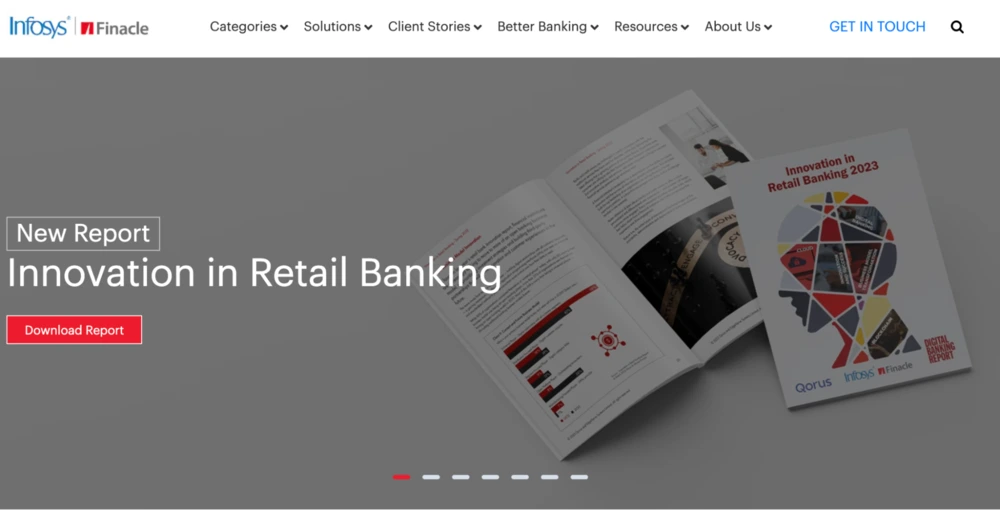
Features of Finacle
Below are some notable features of Finacle.
- Composable architecture supports various modern and traditional customer engagement channels, enterprise capabilities, lines of business components, and business segments.
- Flexible deployment allows banks to deploy and upgrade solutions flexibly according to their business priorities.
- Engagement hub helps banks onboard, sell, service, and converse better with customers.
- Innovation support empowers banks to innovate better, creating new value and enhancing competitiveness.
Benefits of Finacle
Finacle offers several benefits, including:
- Improved customer engagement empowers banks to improve their Net Promoter Score (NPS) by an average of 19%, reflecting improved customer satisfaction and loyalty.
- Cost reduction enables banks to lower their cost-to-income ratio by 3.9% points compared to their peers, thus enhancing their profitability.
- Agile solutions help banks adapt to market changes.
- Global coverage enables banks to scale their digital transformation efforts globally.
Pros and cons
Pros |
Cons |
|
Easy to use and can print and generate reports easily |
The privacy of sensitive information can be improved (G2) |
|
Helps banks to manage the complete credit cycle |
Inability to use APIs to connect to its database (G2) |
|
Tracks compliances |
Difficult to customize the software according to the needs (G2) |
Pricing
Finacle provides custom pricing based on an organization’s requirements from the banking solution. Contact the team to get a quote.
Rating
Users give 4.1 out of 5 stars to Finacle on popular reviews platforms.
Quick Read: Cash Management System – Types, How It Works and Best Practices
5. Flinks
Flinks facilitates secure financial data sharing, enabling you to build superior digital banking experiences. It lets you glean insights from enriched data and enables customers to share data safely with fintech applications essential to your business.
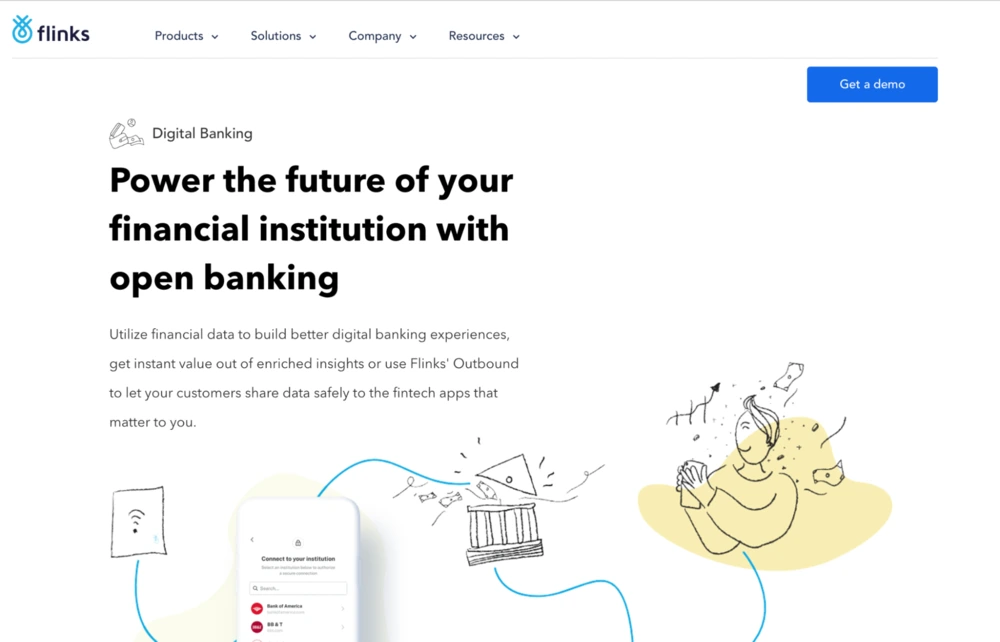
Features of Flinks
Below are some notable features of Flinks.
- User-permissioned data access enables institutions to connect to user-permissioned data to provide enriched insights and services. It includes Know Your Customer (KYC) data, account data, and transactional data.
- Financial data enrichment enhances raw financial data with additional contextual information, facilitating better decision-making and personalized offerings.
- Flinks’ Outbound allows customers to share their data safely with other fintech applications, fostering a collaborative and open banking ecosystem.
- Secure data transfer ensures the safe transfer of files from the front end to the document repository system for safekeeping.
Benefits of Flinks
Flinks offers several benefits, including:
- Optimized credit underwriting. Access to enriched financial data allows prime lenders to optimize credit underwriting processes, reduce defaults, and better manage portfolio risk.
- Hyper-personalized products. For credit card providers, Flinks facilitates the delivery of hyper-personalized products, keeping you at the center of your customers’ financial life.
- Enhanced onboarding experience. For auto-financing institutions, Flinks provides a seamless onboarding experience and mitigates the risk of defaults.
- Safe financial data sharing. Flinks allows institutions to provide their customers with a secure data-sharing environment, fostering increased adoption of leading fintech and gaining control over usage.
Pros and cons
Pros |
Cons |
|
Easy to implement APIs |
Relies heavily on screen scraping data from your online banking (G2) |
|
Steady service with predictable outcomes |
High charges for their solutions (G2) |
|
Highly responsive and agile |
Connection time-outs to banks are very cumbersome (G2) |
Pricing
Flinks provides custom pricing based on an organization’s requirements from the banking solution. Contact the team to get a quote.
Rating
Users give Flinks 4.4 out of 5 stars on popular reviews platforms.
Quick Read: 6 Best Cash Flow Management Software
6. Turnkey Lender
Turnkey Lender offers an all-in-one loan management platform to streamline your credit processing with AI-powered decision-making algorithms, machine learning, and extensive integration capabilities.
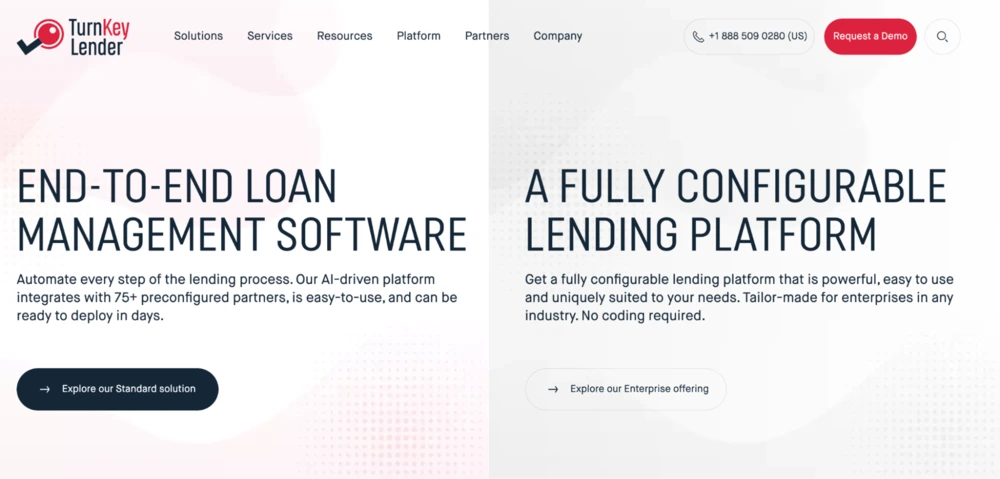
Features of Turnkey Lender
Below are some notable features of Turnkey Lender.
- Proprietary AI: Leverage AI-powered decisioning algorithms and machine learning to automate your credit processing and make smarter, faster loan decisions.
- Loan underwriting: Utilize in-depth risk scoring, borrower evaluation, decision rules checks, loan agreement generation, and loan offer management capabilities.
- Powerful credit product builder: Design flexible credit products with complex schedules, fees, taxes, and interest. It allows configurable rules and auto-generates loan statements.
- Enterprise-grade reporting: Automate configurable or pre-defined dynamic reports to gain unparalleled insights in seconds.
Benefits of Turnkey Lender
Turnkey Lender offers various benefits, including:
- Increased efficiency: Utilizing AI-powered algorithms, TurnKey Lender automates various credit processing tasks, allowing for efficient loan decision-making.
- Improved risk management: You can mitigate risk and improve your underwriting with in-depth risk scoring and a borrower evaluation process.
- Ease of integration: TurnKey Lender can be easily integrated with various systems and providers, simplifying your operations and making your lending process seamless.
- Optimized debt collection: AI-driven tools automate and optimize debt collection, improving recovery rates and reducing costs.
Pros and cons
Pros |
Cons |
|
API documentation is excellent |
Limited to private clients only (G2) |
|
External integrations with sms, email, and payments services |
Limited task management capabilities (G2) |
|
Flexibility in creating different reports for organizational needs |
Needs customization for specific environments (G2) |
Pricing
Turnkey Lender provides custom pricing based on an organization’s requirements from the banking solution. Contact the team to get a quote.
Rating
Users give Turnkey Lender 4.7 out of 5 stars on popular reviews platforms.
Quick Read: Cash Flow Forecasting: Definition, Advantages, and How to Ace It
7. Appway Digital Banking
Appway, now known as FNZ, is a leading provider of digital solutions for wealth managers, providing a platform that automates workflows across people, systems, and data. The platform is renowned for improving the cost-to-income ratio and managing complex compliance requirements.
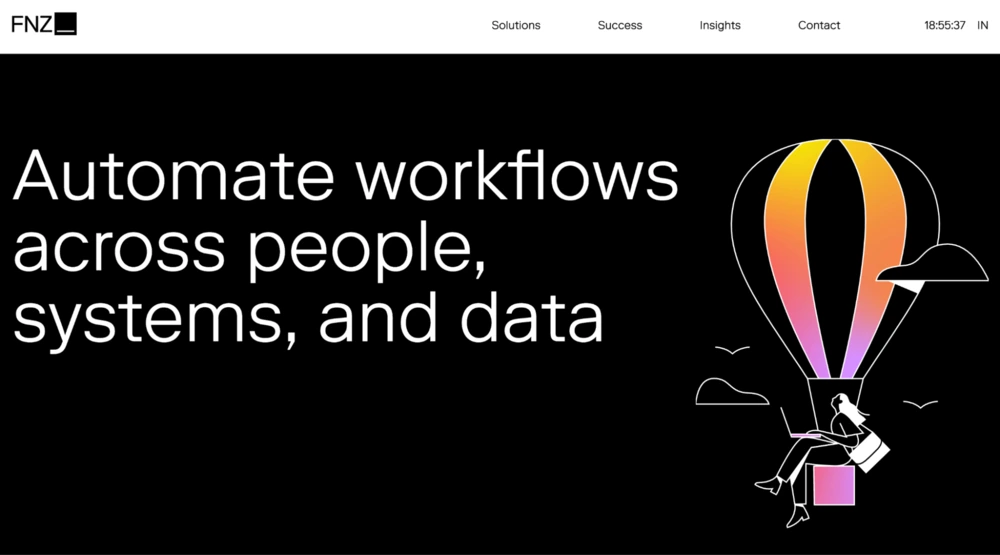
Features of Appway
Below are some notable features of Appway.
- Onboarding for wealth and private banking: Combine digital and physical interactions to offer a personalized onboarding experience that profiles clients through automated questionnaires.
- Client regulatory reviews: Minimize operational costs while enabling ongoing compliance across jurisdictions with data-driven orchestration and holistic regulatory reviews.
- Client administration and servicing: Appway helps boost advisor and operational productivity, providing investors with a personalized, transparent, and hassle-free journey across all channels.
- Risk-based client reviews: Manage client reviews efficiently with a compliance case management workflow.
Benefits of Appway
Appway offers several benefits for its users, including:
- Insightful industry trends: Gain access to the latest trends and research in wealth management, aiding in decision-making and strategy formulation.
- Effective client review management: With Appways compliance case management workflow, client reviews can be managed more efficiently, reducing non-compliance risk.
- Endorsement from top financial institutions: Trusted by leading institutions such as J.P. Morgan Chase Bank, Credit Suisse, and Deutsche Bank, Appway has a strong proficiency in wealth management.
- Improved efficiency: Appway provides a mature platform that adapts to constantly changing regulations and offers business consultation and support, enhancing operational efficiency.
Pros and cons
Pros |
Cons |
|
Detailed process-oriented approach |
Absence of CRM features and chatbot facility (G2) |
|
Quick adoption to market trends and client needs |
High cost of implementation and maintenance (G2) |
|
Extensive automation scope |
Open API is not that great (G2) |
Pricing
Appway provides custom pricing based on an organization’s requirements from the banking solution. Contact the team to get a quote.
Rating
Users give 4.3 out of 5 stars to Appway on popular reviews platforms.
Quick Read: 10 Best Workflow Management Software
8. iCBS
Integrated Computerized Banking System (iCBS) manages and controls banks and financial institutions’ front and back office operations. Offering compliance with international and local regulations, iCBS aligns itself with international standards while catering to local specifications.
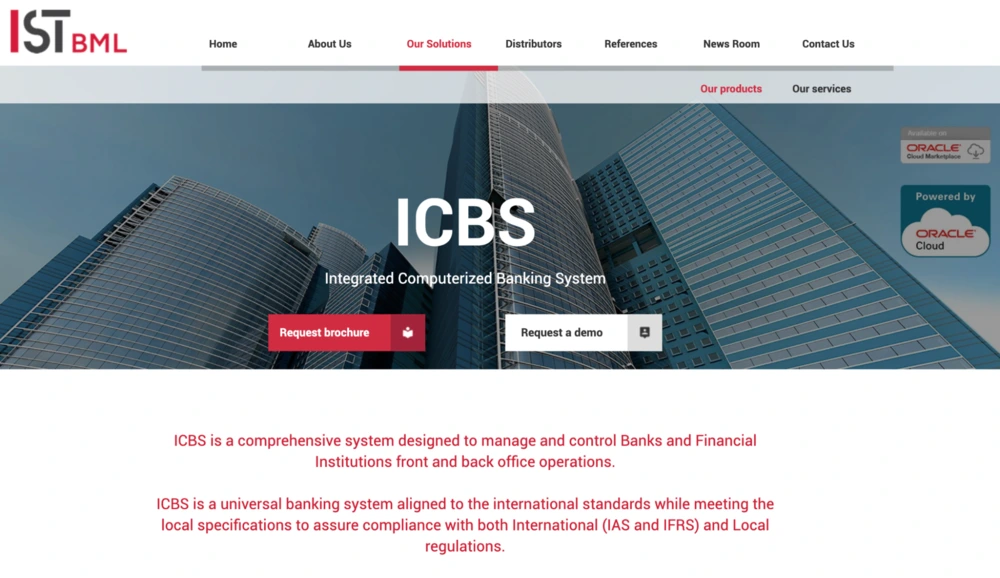
Features of iCBS
Below are the notable features of iCBS.
- Integrated modules and sub-modules allow organizations to acquire only the required functionalities.
- Nucleus module includes security features, referential and parameters, business rules tools, central customer information, and accounting capabilities.
- Ease of integration facilitates seamless integration through standard APIs and provides reusable web and microservices components.
- Audit trails track all interactions and approvals, ensuring accountability and transparency.
Benefits of iCBS
iCBS offers several benefits, including:
- Compliance and standardization ensure compliance with international and local regulations, providing a standardized operational environment.
- Flexible customization allows institutions to tailor the system to their unique needs, improving operational efficiency and reducing extraneous functionality.
- Customer-centric approach centralizes customer information, providing customer-oriented services and a 360° view of customer activities.
- Real-time functionality enhances decision-making capabilities and improves responsiveness.
- Scalability makes it suitable for financial institutions of varying sizes and operational volumes.
Pros and cons
Pros |
Cons |
|
Permits user to access and open multiple accounts |
Customers are not involved in module design (G2) |
|
Effective customization |
Not all the programs have a maker and checker mechanism (G2) |
|
Easy to use |
Limited reporting and queries (G2) |
Pricing
iCBS provides custom pricing based on an organization’s requirements from the banking solution. Contact the team to get a quote.
Rating
Users give 4.2 out of 5 stars to iCBS on popular reviews platforms.
Quick Read: Cash Flow Statements: A Comprehensive Guide
9. Finflux
Finflux democratizes lending by accelerating loan origination, underwriting, and collection processes. It provides a unified underlying lending technology, ensuring flexibility and efficiency across diverse loan types.
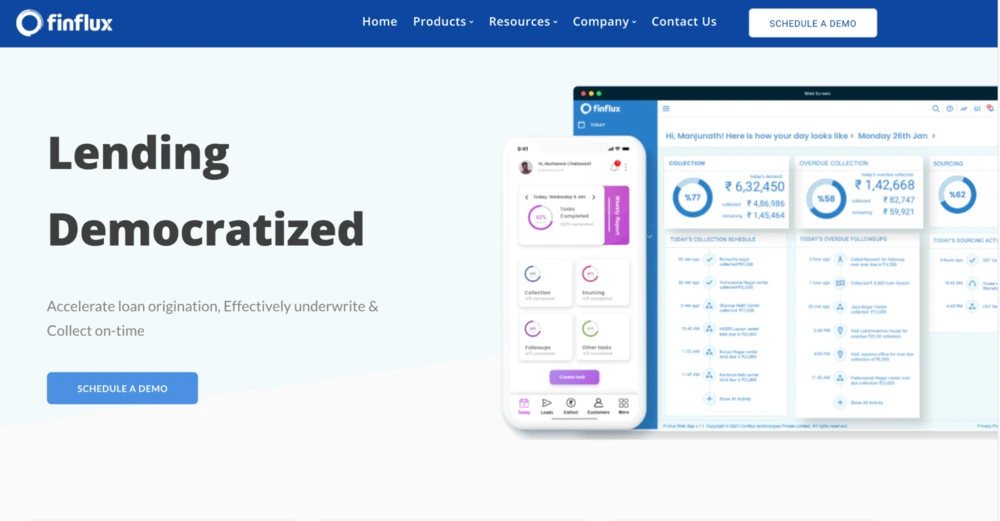
Features of Finflux
Below are some notable features of Finflux.
- Versatility. Finflux caters to a wide range of financial institutions, each with unique needs but unified by a common lending technology.
- Supports various loan types. Finflux Cloud can manage a multitude of loan types, including group loans (JLG), SME loans, personal loans, payday loans, digital lending, auto loans, and various others.
- Ease of use. Finflux prioritizes user experience with its design, ensuring ease of use and effortless business operations for its clients.
Benefits of Finflux
Finflux offers several benefits, including:
- Streamlined lending process accelerates loan origination, underwriting, and collection, leading to increased efficiency and reduced time-to-market for loan products.
- Versatile applications serve various financial institutions while accommodating varying business models and lending needs.
- Global reach allows Finflux to support financial institutions operating in multiple jurisdictions, ensuring compliance with local regulations and standards.
- Quality of support assures a seamless and satisfactory experience for clients, contributing toward a rising reputation for ease of doing business.
Pros and cons
Pros |
Cons |
|
Many modules in a single application |
Absence of flexibility for bulk operations (G2) |
|
Amazing support team |
Advance payments are not getting adjusted on EMI due date (G2) |
|
Support for multiple loan types |
Minimal set of standard reports (G2) |
Pricing
Finflux provides custom pricing based on an organization’s requirements from the banking solution. Contact the team to get a quote.
Rating
Users give 4.7 out of 5 stars to Finflux on popular reviews platforms.
Quick Read: 10 Best Financial Management Tools
10. MX
MX empowers businesses and consumers to do more with their financial data. It provides robust, secure, and actionable financial data insights, improving consumer outcomes and business growth.
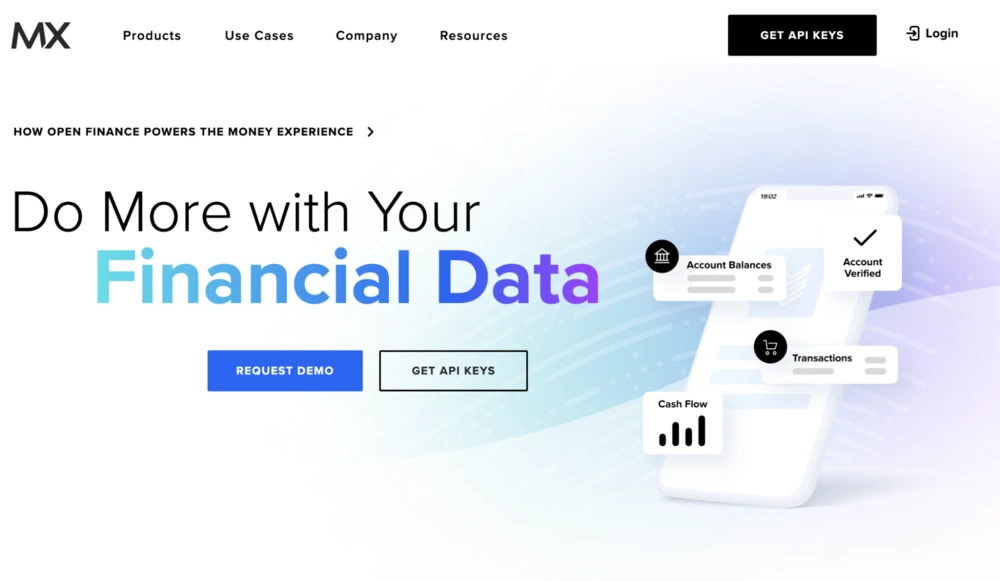
Features of MX
Below are some notable features of MX.
- Optimized connectivity to securely link and verify financial data with industry-leading connectivity solutions.
- Account aggregation offers a comprehensive overview of financial accounts, streamlining data management.
- Balance checks ensure timely and accurate account information.
- Financial insights provide meaningful insights from financial data to inform decision-making.
Benefits of MX
MX offers several benefits, including:
- Data enhancement allows businesses to extract more value from their data, leading to more informed decision-making.
- Powerful user experiences to build compelling, personalized user experiences that foster customer loyalty and drive business growth.
- Large-scale data processing operates with over 100M transactions daily while handling substantial volumes of financial data.
- Improved financial strength empowers businesses and consumers to be financially strong through crucial insights and tools.
Pros and cons
Pros |
Cons |
|
Great support and customer commitment |
Development of the app is not fully supported (G2) |
|
Ease of use |
Lacks Android support (G2) |
|
Ease of payment acceptance and credit card storage |
Absence of KYC and KYB services (G2) |
Pricing
MX provides custom pricing based on an organization’s requirements from the banking solution. Contact the team to get a quote.
Rating
Users give MX 4.7 out of 5 stars on popular reviews platforms.
Quick Read: 10 Best Finance Software for Personal and Business
What is banking software?
Banking software is a digital solution banks and financial institutions use to manage their operations more efficiently and effectively. It includes features like account management, loan origination and servicing, transaction tracking, risk management, and customer service. Banking software can facilitate everything from basic day-to-day transactions to complex financial calculations and reporting.
Quick Read: Financial Modelling: Types, Process, Components and Software
What is the purpose of banking software?
Banking software aims to simplify and streamline the processes involved in financial transactions, management, and reporting. By automating many routine tasks, you can focus on customer service and other strategic initiatives.
In addition, modern banking software provides valuable insights from data analytics, aiding in decision-making and policy development.
Quick read: 10 Best Bookkeeping Software in 2023
Types of banking software
Below are some common types of banking software.
- Core banking systems handle daily banking operations like processing transactions, updating balances, managing account records, and serving customer needs. They are central to a bank’s IT infrastructure, enabling seamless operations.
- Loan origination systems streamline the process of creating and managing loans. It automates various loan process steps such as application processing, underwriting, credit decisions, and document preparation, reducing errors and improving efficiency.
- Payment processing systems handle various types of payments, including wire transfers, electronic fund transfers, check processing, card transactions, and online payments. They ensure all transactions are properly processed.
- Risk management systems help banks identify, assess, and mitigate risks. These include credit, market, operational, and liquidity risks. They use complex algorithms to predict potential risks and provide alerts to prevent losses.
- Fraud detection systems use advanced analytics and machine learning to identify unusual or suspicious activities that might indicate fraud. They monitor real-time transactions, providing alerts when potentially fraudulent activities are detected.
- Compliance software helps banks meet the various regulatory requirements they must adhere to. It includes anti-money laundering (AML) regulations, know-your-customer (KYC) rules, and other national and international banking regulations.
- Treasury management systems enable banks to manage their liquidity and handle their investments and other financial assets. They also aid in planning, executing, and reporting on the bank’s treasury operations.
- Digital banking platforms provide online and mobile banking services to customers. They allow customers to check their balances, execute transactions, apply for loans, and access other banking services from their digital devices.
Here’s a quick read on: Balance Sheet: Meaning, Types, Components & Examples
Importance of banking software
Banking software plays a critical role in the modern financial landscape, contributing to the efficiency, security, and customer-centricity of banking operations. It automates routine tasks, reducing the need for manual labor and lowering the risk of human errors. This increases efficiency and productivity, enabling banks to handle larger volumes of transactions and customer interactions with greater speed and accuracy.
With features like online banking, mobile banking, and personalized customer relationship management, banking software allows banks to provide superior, round-the-clock service. It makes banking more convenient for customers, enhancing their overall experience and satisfaction. There are various other benefits of banking software discussed in subsequent sections.
Learn about: Global Cash Visibility: Basics, Challenges, Best Practices
How banking software revolutionizes the financial industry?
Banking software has digitized financial services, eliminating the need for physical bank visits for many transactions. Customers can now perform banking tasks from anywhere, at any time, using internet-connected devices. This transformation has made banking more accessible and convenient, leading to a surge in financial inclusion globally.
By collecting, storing, and analyzing massive volumes of data, banking software empowers financial institutions to make more informed decisions. This data-driven approach allows for improved risk assessment, customer segmentation, personalized marketing, and predictive analytics.
In terms of automation, security, innovation, and cost reduction, banking software is playing a key role in the modern banking landscape.
Quick read: Financial Accounting: Definition, Types, Functions & Examples
Advantages of banking software
Banking software offers many advantages for financial institutions and their customers:
- Efficiency: Banking software significantly reduces manual efforts in processing transactions, handling customer requests, and other banking activities. It leads to faster operations.
- Convenience: The software allows customers to access banking services 24/7 from anywhere worldwide, offering high convenience. Users can perform banking tasks like fund transfers and bill payments without visiting a physical branch.
- Improved customer experience: By providing personalized services, quick response times, and easy-to-use interfaces, banking software greatly enhances the customer experience. Features like transaction history, spending analytics, and notifications further enrich customer engagement.
- Cost reduction: With the automation of various processes, banking software reduces the operational costs for banks. These savings can be used to improve services or passed on to customers through lower fees.
- Security and compliance: Advanced encryption techniques, multi-factor authentication, and other security measures in banking software help protect user data and prevent fraud.
- Data analysis and decision-making: Banking software provides valuable insights into customer behavior, market trends, and operational performance. It helps bankers make strategic decisions, enhance customer service, and develop new products or services.
- Scalability: As a bank grows, its software can be easily upgraded or expanded to meet increased demand. Scalability is crucial for banks to accommodate growth without disruption to services.
Challenges in implementing the banking software
Although implementing banking software can bring numerous benefits, it also comes with several challenges:
- Data security and privacy: With the increase in digital transactions, the risk of cyber threats and data breaches have also escalated. Banks must ensure robust security measures are in place to protect sensitive customer data and maintain trust.
- Integration with existing systems: Often, banks have legacy systems in place, which can be difficult to integrate with new software. Ensuring seamless interoperability might require additional effort, time, and resources.
- User adoption: Getting staff and customers to adopt new software can be challenging. Training may be needed to ensure everyone understands how to use the new system effectively.
- Costs: Implementing new banking software can be expensive. Banks need to account for the cost of the software itself, as well as the costs associated with training, integration, maintenance, and upgrades.
- Change management: Transitioning to a new system can significantly change an organization. Banks must manage this process carefully to minimize employee disruption and resistance.
- Vendor selection: Choosing the right software and vendor can be complex. Banks must evaluate several factors, including the vendor’s reputation, the software’s capabilities, customer support, and the cost.
Quick Read: 9 Best Vendor Payment Management Software
How to choose the right banking software
Choosing the right banking software is a critical decision for financial institutions. Here are some factors to consider:
- Understand requirements. First, identify and document your specific needs. What functionalities are you looking for? What are your goals for the software? Knowing your requirements will help guide your search.
- Ease of use. Choose software user-friendly and intuitive software, both for your employees and your customers. It will ease the transition and increase the likelihood of successful adoption.
- Security: The software should have robust security measures in place to protect sensitive data and comply with relevant regulations. It includes encryption, two-factor authentication, and regular security updates.
- Integration capabilities. The software should be able to integrate seamlessly with your existing systems. This includes your CRM, accounting software, and other business tools.
- Customer support. A reliable and responsive customer support team is crucial. They should be available to answer any questions and help troubleshoot issues when needed.
- Cost. Consider the total cost of the software, including purchase price, implementation costs, training expenses, and ongoing maintenance and upgrades.
Future trends and innovations in banking software:
Banking software is a dynamic field, with emerging trends and innovations poised to revolutionize financial institutions’ operations. Artificial Intelligence (AI) and Machine Learning (ML) are increasingly prevalent in banking software. AI can help with everything from risk assessment to customer service (through chatbots), while ML can help financial institutions understand their customers better, detect patterns, and predict future trends.
On the other hand, open banking is attracting more eyeballs. Open banking is a system where banks share user data with third-party developers to create new, innovative financial services. This allows for increased competition and innovation within the industry.
Furthermore, more and more financial institutions are moving their operations to the cloud for greater flexibility and scalability. This also helps reduce the cost of infrastructure and enables better data management.
Bottom line
In conclusion, banking software plays a crucial role in today’s financial landscape, offering a range of benefits to banking institutions and their customers. It facilitates seamless financial transactions and enhances operational efficiency.
However, the software’s implementation has challenges, including security concerns and regulatory compliances. Therefore, financial institutions must exercise careful consideration when choosing the right banking software that aligns with their specific needs and goals.
In banking and finance, trust is the currency, and effective banking software is the mint where this currency is forged.
FAQs
A bank’s business, network infrastructure, and payment network are the three pillars of modern banking.
There are several software like core banking solutions, digital banking software, loan origination system, and loan management tools.
Yes, Finacle is a banking software.
Core banking systems, digital payments software, CRM software, and many other tools are crucial in creating a bank account.
Banking software refers to the individual applications or programs banks use to facilitate their operations. On the other hand, banking systems are core banking software. They refer to the full suite of technology infrastructure that a bank uses to conduct its business.

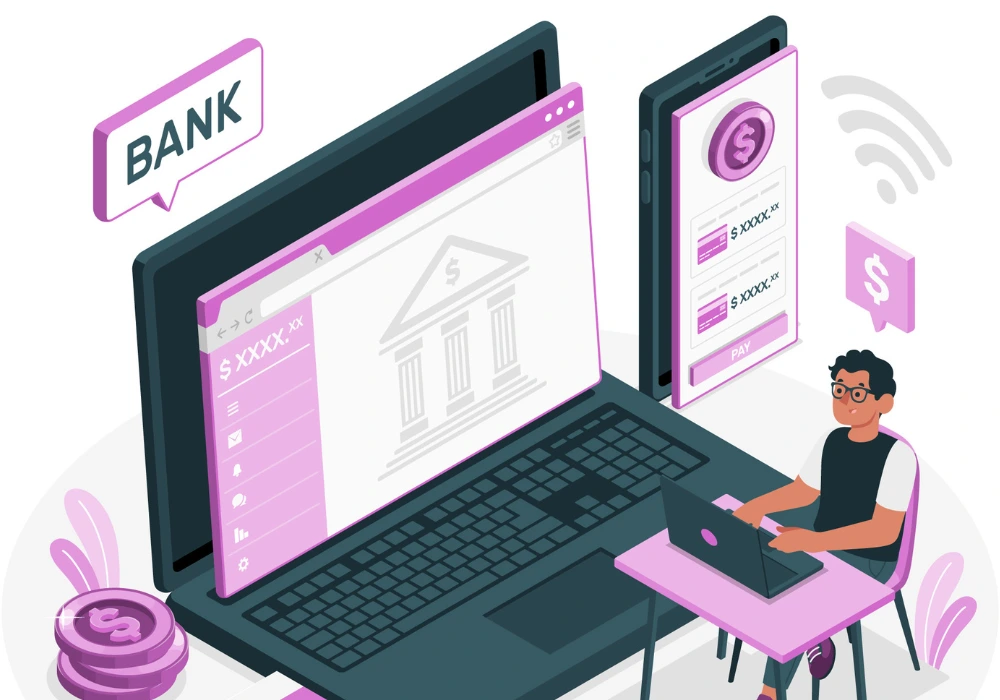

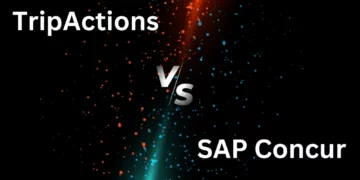

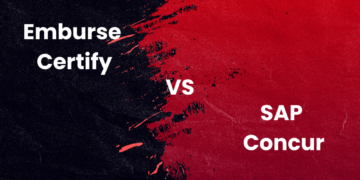
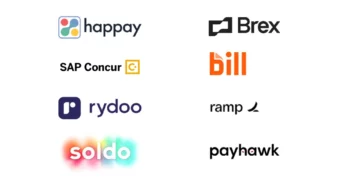
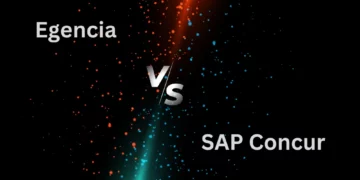


Discussion about this post